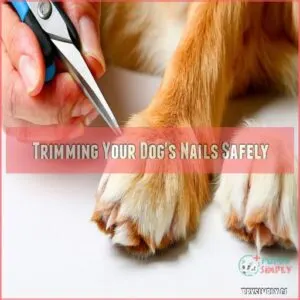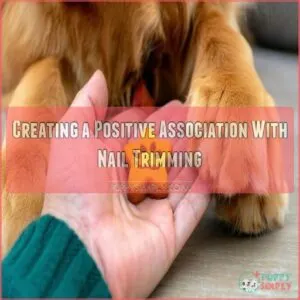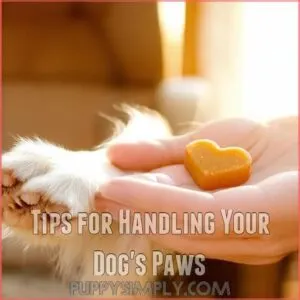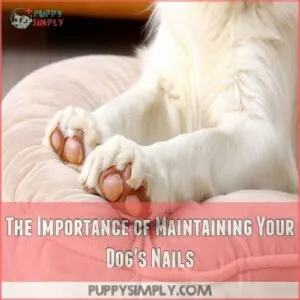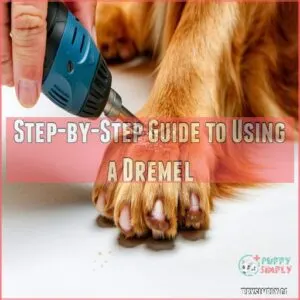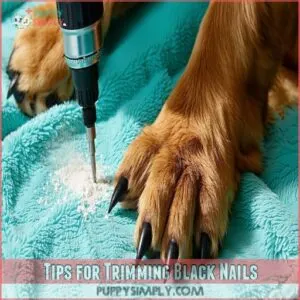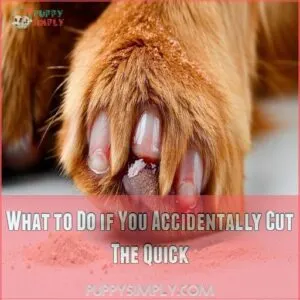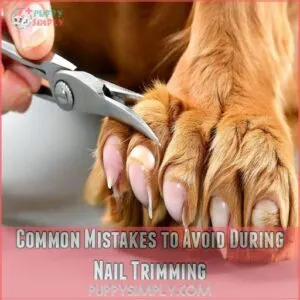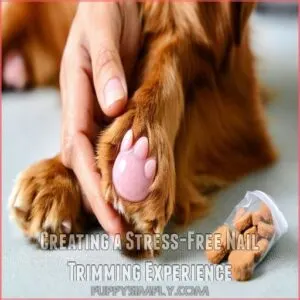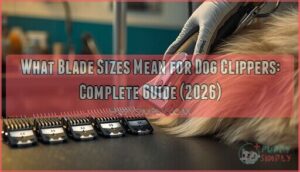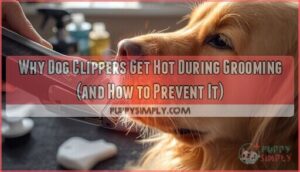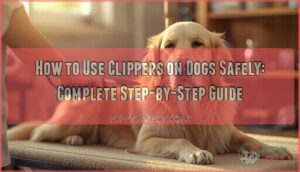This site is supported by our readers. We may earn a commission, at no cost to you, if you purchase through links.
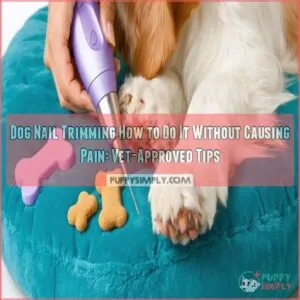 Trimming your dog’s nails without causing pain is all about preparation and the right tools.
Trimming your dog’s nails without causing pain is all about preparation and the right tools.
First, get your dog used to paw handling—massage those toes during cuddle time and pair it with treats.
Switch to a Dremel grinder instead of clippers for smooth, pinch-free trimming (a quiet, cordless model works best).
Only grind tiny bits at a time to avoid hitting the quick—the sensitive part inside the nail.
Desensitize your pup to the Dremel’s sound gradually and reward calm behavior.
Remember, patience pays off, and a little snack goes a long way!
Ready to make nail trimming stress-free? Let’s begin.
Table Of Contents
- Key Takeaways
- Trimming Your Dog’s Nails Safely
- Getting Your Dog Comfortable With Nail Trimming
- The Importance of Maintaining Your Dog’s Nails
- How to Trim Your Dog’s Nails Without Causing Pain
- Common Mistakes to Avoid During Nail Trimming
- Creating a Stress-Free Nail Trimming Experience
- Frequently Asked Questions (FAQs)
- How to trim dog’s nails without hurting them?
- What to do if your dog won’t let you cut their nails?
- Does clipping a dog’s nails hurt them?
- How can I calm my dog down to clip his nails?
- How to trim dog nails without hurting them?
- How can I cut my dog’s nails if she wont let me?
- Do dogs feel pain while cutting nails?
- What is the alternative to nail clipping dogs?
- How often should I trim my dogs nails?
- Can I use human nail clippers on dogs?
- Conclusion
Key Takeaways
- Get your dog comfortable with paw handling and desensitize them to the Dremel or clippers by pairing gradual exposure with treats and praise.
- Use a Dremel grinder instead of clippers for safer, smoother trimming, and avoid hurting the quick by grinding small bits at a time.
- Trim nails in a calm, well-lit environment, stopping frequently to reward your dog’s behavior and prevent stress.
- Don’t rush the process, avoid cutting too much at once, and stay alert to signs of distress or discomfort to keep the experience pain-free.
Trimming Your Dog’s Nails Safely
Keeping your dog’s nails trimmed safely doesn’t have to feel like a stressful chore.
With the right tools, patience, and a few treats at hand, you can make the experience easier for both of you.
Understanding The Risks of Nail Clippers
Nail clippers might seem simple, but they’re not always the safest tool for a painless nail trim.
They can crush or pinch the nail, causing discomfort—especially if your trimming techniques aren’t spot-on.
Guillotine clippers need practice, and human nail clippers can lead to nail damage.
Understanding nail clipper safety helps you avoid cutting too much and ensures painless nail trimming.
To achieve this, to make certain you follow proper dog nail care techniques to prevent pain and injury.
Benefits of Using a Dremel for Nail Trimming
Tired of the stress that comes with clippers? A Dremel makes nail care smoother. Instead of sudden snips, it gently grinds nails, giving you control while avoiding the dreaded quick.
This tool is especially handy for dogs with black nails or sensitive paws.
- Dremel Safety: No squeezing or splitting like clippers.
- Pet Comfort: The gentle vibration is less scary than a snap.
- Pain Prevention: Gradual nail grinding means a painless nail trim.
How to Choose The Right Dremel for Your Dog
To pick the perfect Dremel for a painless nail trim, think about your dog’s comfort first.
A quiet motor and adjustable speeds between 10,000–15,000 RPM make nail grinding stress-free.
Cordless models offer easier pet grooming, while lightweight tools reduce strain.
Look for safety features like nail guards and sanding attachments for precise, safe trimming.
When selecting a Dremel, consider visiting a dog nail guide to guarantee you’re making an informed decision for your pet’s nail care.
Preparing Your Dog for Nail Trimming
Before grabbing that Dremel, nail prep starts with building dog comfort.
Paw handling from a young age can make all the difference in stressfree trimming.
Treat your pup’s paws like fragile treasures—gentle and consistent.
Here’s how to make paw care a breeze:
- Handle paws during cuddle time, teaching them it’s part of normal life.
- Massage their toes lightly, adding belly rubs for bonus points.
- Turn trimming into snack heaven—stick peanut butter on a mat and let them enjoy while you work.
These nail trimming tips lead to painfree, fearfree trimming!
Getting Your Dog Comfortable With Nail Trimming
Getting your dog used to nail trimming might take some patience, but it’s worth it for a stress-free experience.
With a little practice and plenty of treats, you’ll both feel more confident in no time.
Desensitizing Your Dog to The Dremel Sound
Start by introducing the Dremel sound gradually at a safe distance to reduce canine anxiety.
Let your dog hear it during play or treat time—pairing noise with rewards works wonders.
Slowly bring it closer over days, keeping sessions short.
This sound desensitization technique builds trust, paving the way for painless and stress-free trimming and fear-free nail grinding success.
For further guidance, you can explore how to get your dog used to it with step-by-step desensitization techniques.
Rewarding Good Behavior During Nail Trimming
Rewarding good behavior is how you make nail trimming a fear-free, even fun, part of your pup’s routine.
Use treat-based rewards to keep things positive and stress-free.
- Treat Time: Offer high-value treats after each nail for a steady reward system tied to calm behavior.
- Praise Overload: A little “good job!” and belly rubs go a long way.
- Post-Trim Fun: Wrap it up with gentle handling and their favorite game for a double win!
Creating a Positive Association With Nail Trimming
It’s all about making nail care feel like a treat, not a chore.
Use high-value treats and lots of praise as Dog Rewards to keep trimming techniques stress-free.
Treat after each paw, then give a big reward when you’re done.
Dogs love predictable routines!
| Step | Action | Reward | Purpose |
|---|---|---|---|
| 1 | Handle a paw gently | Small treat | Build canine comfort |
| 2 | Trim one nail | Praise | Reinforce gentle trimming |
| 3 | Finish a full paw | High-value treat | Boost positive reinforcement |
| 4 | Final nail complete | Favorite snack or toy | Celebrate painfree trimming |
Keep the mood upbeat, and your pup will look forward to nail care!
Tips for Handling Your Dog’s Paws
Getting your dog used to paw handling makes gentle trimming and pain-free trimming a breeze.
Start with a paw massage—most dogs love it, and it’s a great way to help them relax. Don’t rush; ease into nail inspection by rewarding calm behavior. Add a mix of calming techniques, like soft praise or belly rubs, to keep things pleasant.
- Massage your dog’s paws to keep them relaxed
- Use a gentle touch to reduce nervousness
- Pair paw handling with treats
- Introduce tools during playtime
- Practice consistent positive reinforcement
The Importance of Maintaining Your Dog’s Nails
Keeping your dog’s nails trimmed isn’t just about looks—it’s key to their comfort and overall health.
Long nails can cause pain, make walking awkward, and even lead to more serious issues, so regular trimming is a must.
Why Regular Nail Trimming is Crucial for Health
Why’s regular dog nail trimming such a big deal?
It keeps your pup’s paws healthy and happy by reducing pain and preventing injuries like torn nails or joint damage.
Long nails mess with their posture and mobility, while proper trimming enhances hygiene and even improves their gait.
Regular trims are your secret to maintaining excellent canine nail health and overall well-being.
Consequences of Neglecting Nail Maintenance
Neglecting your dog’s nails can snowball into serious nail problems.
Nail overgrowth isn’t just unsightly—it can lead to nail damage, joint damage, and even painful nail breakage.
Overgrown nails may press into the pads or crack, risking nail infections that need veterinary care.
Skipping trims puts your dog’s canine nail health at risk, affecting posture and mobility.
Stay consistent to avoid preventable health risks and pain issues for your pup.
How to Check if Your Dog’s Nails Need Trimming
Wondering if your dog’s nails are overdue for trimming?
Do a quick nail inspection by watching for clicking sounds on hard floors or nails that curl downward.
Gently hold their paw and check for nail damage or discomfort.
Healthy nails are smooth and just above the floor when standing.
Regular nail length checks protect paw health and prevent painful nail problems!
Frequency of Nail Trimming for Different Breeds
How often should you grab the clippers or Dremel? Nail trimming frequency isn’t one-size-fits-all—it depends on breed size, activity, and lifestyle.
Large active breeds, like Labs, often need trimming every 4–6 weeks, while smaller breeds, like Chihuahuas, can go 6–8 weeks.
Regular trims keep nails from overgrowing and causing issues.
Consult your vet for a breed-specific trimming schedule—it’s a small task that makes a huge difference in your dog’s comfort!
How to Trim Your Dog’s Nails Without Causing Pain
Trimming your dog’s nails doesn’t have to be a stressful experience if you use the right tools and techniques.
With a little patience, the right approach, and a steady hand, you can keep your pup’s nails healthy and pain-free.
Step-by-Step Guide to Using a Dremel
To start painless trimming with a Dremel, prioritize Dremel safety by holding it at a 45-degree angle and grinding in short bursts to prevent overheating.
Focus on nail anatomy, avoiding the quick.
For the right tools, explore a dog nail Dremel selection.
Use low-speed settings for control and firmly grip your dog’s paw for stability.
Offer treats and praise to keep your dog’s comfort and trust intact throughout.
Tips for Trimming Black Nails
Trimming black nails can feel tricky, but it’s all about confidence and control.
Black nail care is safer if you focus on nail anatomy and use the right trimming techniques. Start with good lighting to spot details better and work methodically with a Dremel at low speed. Watch for a dark, chalky dot—the quick’s starting point.
For a less stressful experience, try restraint-free handling techniques.
Here’s your checklist:
- Use strong light to see nail structure clearly.
- Go slow—gradual grinding prevents mistakes.
- Check for the dark circle as a stopping cue.
- Reward your pup to reinforce painless trimming.
Stay patient, and you’ve got this!
What to Do if You Accidentally Cut The Quick
Oops, cut the quick? Stay calm—it happens!
Grab styptic powder for quick stop emergency care. No powder? Cornstarch or soap work too.
Apply pressure to the nail and coat it to halt nail bleeding. Keep your dog calm with soothing words.
These dog nail trimming tips make pain management simple while turning a mishap into a small bump, not a crisis, with quick stop care.
Common Mistakes to Avoid During Nail Trimming
It’s easy to make mistakes when trimming your dog’s nails,
but avoiding them can save you and your pup a lot of stress.
From rushing the process to ignoring your dog’s discomfort,
knowing what not to do will make nail trimming smoother and safer for everyone,
as it helps in avoiding mistakes.
Rushing The Process and Causing Stress
Rushing nail trimming can turn a calm pup into a ball of nerves.
Slow and steady wins this race—stress reduction is your goal for painfree nail cutting.
- Use calming techniques like gentle handling and soothing tones.
- Stop frequently to prevent dog anxiety or stress.
- Reward them with treats or belly rubs after each nail.
Relaxation methods matter!
Forcing Your Dog Into an Uncomfortable Position
Shoving your dog into an awkward position can backfire, creating canine stress or even dog anxiety.
Instead, use gentle paw restraint that feels natural. Try positions like standing, side-lying, or even sitting in your lap—choose whatever makes your pup comfortable.
Forced handling increases dog pain and nail trauma risks, so skip the power struggle.
Remember, your dog’s comfort matters; it’s the foundation of a stress-free grooming session. Positive reinforcement seals the deal!
Clipping Too Much at Once and Causing Pain
For dog nail trimming, avoid clipping too much at once—it’s a fast-track to painful trimming and potential nail damage.
Cutting deeply can lead to a dreaded quick injury, leaving your pup stressed and fearful.
Take it slow, trim tiny bits, reassess often, and use proper dog nail trimming techniques to keep your furry friend pain-free and relaxed.
Ignoring Signs of Distress or Discomfort
Pay attention to pain signals and stress indicators, like:
- Excessive panting or drooling.
- A tucked tail, flattened ears, or hiding.
- Growling, whining, or attempting to pull away.
- Snapping or a dog bite during a nail trim.
Proper nail trimming techniques can help minimize these anxiety triggers and create a more positive experience for your dog.
Rushing past these anxiety triggers can lead to fear responses. Stop, soothe their sensitive paws, and retry later with calm reassurance.
Creating a Stress-Free Nail Trimming Experience
Creating a stress-free nail trimming experience starts with helping your dog feel safe and relaxed.
With patience, treats, and a little bit of practice, you can turn this task into a routine that’s easy for both of you.
Gradually Introducing Your Dog to Nail Trimming
Easing your pup into nail trimming starts with paw preparation. During cuddle time, gently handle and massage their paws. This practice helps them associate paw contact with relaxation, building dog comfort over time.
Keep sessions short and calm, especially if your pup’s new to this. Bring in the tools early—let them sniff the Dremel or clippers. This step reduces curiosity and anxiety.
To tackle stress reduction, switch the Dremel on at a distance so they adjust to the sound. Gradually bring it closer, rewarding calm behavior throughout.
Focus on gentle handling and gradual steps. A little patience now avoids clipping dogs nails when afraid later on!
Using Positive Reinforcement Techniques
Think of positive reinforcement as the secret sauce for safe trimming.
Use reward-based training by offering high-value treats—peanut butter, freeze-dried liver, or cheese work wonders. Don’t just toss a snack; pair it with gentle handling and a cheerful “Good job!” to build trust.
Keep a calm environment to reduce stress. Consistent positive feedback fuels your dog’s confidence, making nail trimming feel less like a chore and more like a bonding session.
Making Nail Trimming a Positive Experience
Making nail trimming fun starts with dog relaxation.
Try a soothing paw massage before reaching for any tools.
Use treats your dog loves or a puzzle toy to keep their focus away from the trimming.
Incorporate positive reinforcement by pausing for praise or snacks after each small success.
Understanding nail trimming techniques is important for a stress-free experience.
These calming methods make safe trimming effortless while boosting your dog’s wellbeing.
Tips for Trimming Nails in Different Environments
To master nail trimming in any setting, here are some handy tips:
- Outdoor Trimming: Pick a calm, well-lit area free of distractions.
- Home Setup: Use a stable surface like a grooming table or floor mat.
- Public Places: Pack portable tools for easy use.
- Travel Tips: Carry compact trimmers to keep nail care seamless on the go.
Frequently Asked Questions (FAQs)
How to trim dog’s nails without hurting them?
Trimming a dog’s nails is like carving a soft sculpture—patience and precision matter.
Hold the paw gently, trim small bits at a time, avoid the quick, and reward them with treats and pets afterward.
What to do if your dog won’t let you cut their nails?
If your dog won’t let you trim their nails, try desensitizing them gradually with treats and praise.
Start by handling their paws daily.
If stress persists, consider using a professional groomer or your vet for assistance.
Does clipping a dog’s nails hurt them?
Hurting your dog during nail trimming isn’t inevitable—just avoid cutting into the “quick”, the sensitive part of their nail.
Use proper tools, take small snips, and reward them like they’ve just won an Oscar!
How can I calm my dog down to clip his nails?
Start with belly rubs and treats to set a happy mood.
Gently touch their paws daily so they’re used to it.
Play calming music, use distractions like peanut butter, and reward them after every step.
How to trim dog nails without hurting them?
Ever tried balancing on a wobbly chair?
That’s how overgrown nails feel for your dog.
Trim slowly at a 45° angle, take tiny cuts, avoid the quick, and use treats to keep it stress-free.
How can I cut my dog’s nails if she wont let me?
If your dog won’t let you cut her nails, try desensitizing her to the tools with treats.
Practice touching her paws gently, and trim one nail at a time.
Patience and positive reinforcement work wonders!
Do dogs feel pain while cutting nails?
Dogs can feel pain if you cut their nails too short and accidentally hit the quick, which is full of nerves.
It’s like cutting your own cuticle—ouch!
Take it slow and trim carefully.
What is the alternative to nail clipping dogs?
Using a Dremel is a great alternative—it’s like gently sanding down the nails instead of clipping.
It’s safer, especially for black nails, and avoids the dreaded “snap” sound that can scare dogs.
How often should I trim my dogs nails?
Trim your dog’s nails every 2-4 weeks, depending on how fast they grow and how much they wear naturally.
If you hear clicking on hard floors, it’s time – no dog tap dances by choice!
Can I use human nail clippers on dogs?
Cutting dog nails with human clippers is like trying to chop wood with scissors—it’s risky and ineffective.
Dog-specific tools prevent splitting, pain, and discomfort, giving you better control for safe, comfortable nail care.
Conclusion
Don’t worry if dog nail trimming feels tricky at first—it gets easier with practice.
By using a Dremel, starting slow, and rewarding your dog for patience, you’ll make the process smoother and stress-free.
Regular nail maintenance keeps your pup comfortable and healthy, and with these vet-approved tips, you can do it without causing pain.
Remember, preparation and positive associations are key. Your dog will thank you for the effort!
Ready to give it a shot?
- https://www.akc.org/expert-advice/health/how-to-trim-dogs-nails-safely/
- https://www.reddit.com/r/coolguides/comments/p8diin/how_to_trim_dog_nails/
- https://timberdog.com/blogs/all-blogs/how-i-trim-my-dogs-nails-without-causing-him-fear-or-pain
- https://www.vetcarepethospital.ca/trim-dogs-nails/
- https://www.dogsnaturallymagazine.com/trimming-your-dogs-toenails/

